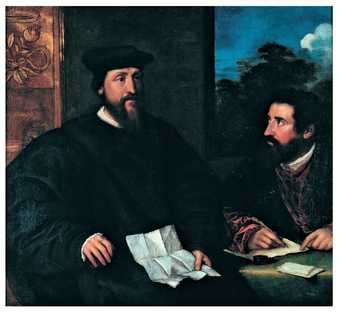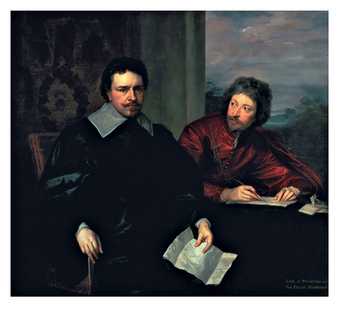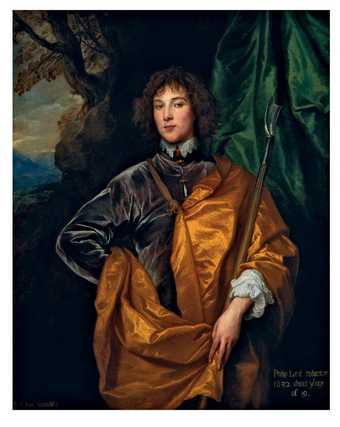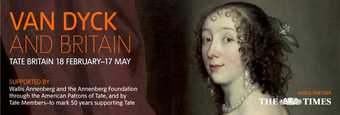Is Anthony van Dyck a British artist? The question may seem obtuse since he was born in the southern Netherlands and trained in Antwerp. On the other hand – and much to some people’s surprise – the New Dictionary of National Biography recently allocated him the second longest entry for a British artist after Turner, and therefore ahead of Hogarth, Gainsborough and Reynolds. Such rankings and classifications may appear faintly absurd, but they mask a serious issue, even though it may seem more important to consider where an artist worked, and for whom, rather than how he or she may fit into the traditional scheme of a national school.
Van Dyck was a restless and peripatetic artist whose output falls into several distinct phases that relate to each of the major countries where he worked, so there is not only a Flemish van Dyck, but also an Italian and a British one. However, his periods of residence in London were surprisingly short. The first was of no more than a few months from October 1620 to March 1621. The second lasted from June 1632 (at the latest) to March 1634, at which point he seems to have been hoping to move on to Madrid to work for Philip IV. Then, following the failure of this plan, he returned to London for his third and longest stay, which lasted from around March 1635, when he was given a new house by Charles I, until his death in December 1641. The two later visits amount to a period of little more than seven years in total, but the influence of his work in this country proved enormous.
My opening question can be answered in two different ways. The first and more conventional is to say that van Dyck brought a way of making portraits to Britain that was fundamentally Italian and specifically Venetian in approach (although filtered through his northern European training). The second is that he displaced an established way of painting that was German and Netherlandish in origin, as can be seen from the work of many artists who practised in London during the second half of the sixteenth century (notably the successive generations of the Gheeraerts family from Bruges and the de Critz family from Antwerp). This argument is similar to the traditional idea that Inigo Jones brought Italian Renaissance architecture to Britain, and, in the process, swept away the dominant building idiom of the sixteenth century, which for many years was dismissed as “artisan mannerism” by architectural historian John Summerson and others. Both points of view imply that the Italian influence was an improvement on what it replaced.
Interestingly, the notion that Jones introduced a “correct” way of building to Britain has been far more robustly challenged in recent years than the claim that van Dyck rescued British art from northern provincialism. Both lines of thinking fail to recognise the internationalism of sixteenth-century British art and architecture, nor do they admit that both Jones and van Dyck may have adapted their knowledge of Italian art to a vigorous native tradition.
Admittedly, Tate Britain’s exhibition offers much evidence to support the traditional, Italianist view, and there is no question that van Dyck reinvented Titian’s work for the British court. For example, Titian’s double portrait of Georges d’Armagnac, Bishop of Rodi, with his secretary Guillaume Philandrier 1536–8 that has been included in the show was owned by the royal favourite, George Villiers, Duke of Buckingham, and it made such an impression on Inigo Jones that he was said to have gone down on his knees before it. Van Dyck used it in a very explicit way as a prototype for his double portrait of Thomas Wentworth, 1st Earl of Strafford, with Sir Philip Mainwaring 1639–40. Many other paintings reveal him adapting ideas from Titian, sometimes from sources encountered during his travels in Italy and copied into a sketchbook during the mid-1620s (now in the British Museum). He also made more obvious use of Titians that were in aristocratic collections in Britain and which could have been known to his patrons at court. But, to my mind, this explains only part of van Dyck’s success with his English patrons.
In fact, the artist was far more responsive to his British context than is often acknowledged. After deciding to settle for a while in London he introduced new formats and new kinds of symbolic meaning into his portraits that had not appeared in his earlier work in the Netherlands or in Italy. At the same time, his way of applying paint and his preferred colour range actually moved away from Titian’s approach (while still sometimes following his compositional example). Van Dyck adopted a smoother paint technique in his British portraits and chose canvases that were less rough in texture than he had used in Italy, as can be seen from the richly textured pendant portraits of two visitors to Rome, Sir Robert Shirley and his wife Lady Teresia, who he painted in 1622 when trying to establish himself in Italy.
More significantly, van Dyck began incorporating Latin texts into his portraits in a way that is never found in his earlier Antwerp work, or that of his teacher Peter Paul Rubens, but which was very much in the spirit of British sixteenth-century portraiture. A key example in the exhibition is the full-length of Lord George Stuart, Seigneur d’Aubigny c.1638–1640, which is inscribed “ME FIRMIOR AMOR” (“Love is stronger than I am”), perhaps an allusion to the sitter’s secret marriage to the daughter of the earl of Suffolk which aroused disapproval at court. This kind of textual declaration can be seen in earlier British portraits, such as the well-known image of the soldier-adventurer Captain Thomas Lee by Marcus Gheeraerts the Younger 1594. On the tree upper left is inscribed “Facere et pati Fortia” (“Act and suffer with fortitude”), taken from Livy’s History of Rome and said by Mucius Scaevola, who held his hand in the flames of an altar to persuade his captor, Porsenna, the leader of the Etruscans, to sue for peace. Lee’s hand hangs limply because of an injury, making the parallel with Scaevola very apt.

Titian
Georges d’Armagnac, Bishop of Rodi, with his secretary Guillaume Philandrier c.1536–9
Oil on canvas
104.1 x1 14.3 cm
Courtesy Collection of the Duke of Northumberland, Alnwick Castle

Anthony van Dyck
Thomas Wentworth, 1st Earl of Strafford, with Sir Philip Mainwaring 1639–40
Oil on canvas
131.8 x 142.9 cm
Courtesy Trustees of the Rt Hon Olive, Countess Filtzwilliam’s Chattels Settlement and Lady Juliet Tedgell
Works of this kind used Roman history and Latin literature to illuminate the sitter’s life. Van Dyck also followed earlier British artists in adapting fanciful and historical costume to make such connections. Stuart is portrayed as an arcadian shepherd not a courtier, while Sir John Suckling 1638, despite being the “greatest gallant of his time and the greatest gamester”, according to John Aubrey, is dressed in Persian costume in allusion to a play he had written, and is accompanied with the very moral text “NE TE QVAESIVERIS EXTRA” (“Do not seek outside yourself ”) from the First Satire of the Stoic author Persius.
Another example is the portrait of the strict puritan, Philip, Lord Wharton c.1632, as a somewhat foppish shepherd. This kind of disguise, although not invented by van Dyck, is a marked departure from his earlier portraits of Flemish and Italian patrons, who almost invariably chose to be painted wearing fashionable modern attire. This was the norm for the British too, of course, but one of van Dyck’s most striking innovations for his women sitters was loose apparel often shown held together by jewelled clasps and broaches at the shoulder and derived from the kind of unspecific dress found in sixteenth century Venetian mythologies and allegories. Described in a memorable phrase by William Sanderson, a near contemporary of van Dyck, as the artist’s “careless romance”, it has often been observed that this probably found favour with women patrons because it avoided the vagaries of fashion and time. Such works are a tiny minority in van Dyck’s output, but the very fact they exist is significant.
He was also asked to paint a number of distinctive double portraits while in Britain. These often show couples of the same gender who may be linked by blood and family ties, but sometimes simply by friendship. One of the most interesting of the latter is in the exhibition and depicts the artist himself alongside Endymion Porter, the Hispanophile courtier (c.1633), their left hands resting on a rock in the foreground, which must surely be a symbol of the durability of their friendship. Such details, together with wilderness settings, urns, fountains, plant symbolism and winged infants are found in many of van Dyck’s British portraits. In the double portrait of two sisters, Dorothy Savage, Viscountess Andover, and Elizabeth, Lady Thimbleby c.1637, the women wear modern, fashionable dress, but the more personal and abstract meaning of their relationship is underlined by the inclusion of a winged and garlanded youth, sometimes identified as an angel, who presents the seated woman with a symbolic basket of roses. Such semi-mythological figures were preferred by van Dyck as attendants for his female sitters, but were avoided in his more worldly depictions of men, even in such extraordinarily elegant pictures as the double portrait of Lords John and Bernard Stuart c.1638, which is arguably as much about their clothes as their faces. These works show the richness of reference to lineage, dynasty and emotion in his British portraits, and the new formats and symbolism that he devised do much the same job as the Latin texts incorporated into his paintings.

Anthony van Dyck
Philip, Lord Wharton c.1632
Oil on canvas
133 x 106 cm
Courtesy the Board of Trustees, National Gallery of Art, Washington
Whether the relentless demands of van Dyck’s British patrons spurred this driven and hyperactive artist to a pinnacle of achievement or to a hectic decline is a matter of opinion. It is clear, though, that this phase in his output was marked by far richer and more inventive layers of meaning, more subtle personal associations between sitters and a greater variety of motifs, symbols and textual allusion than in his earlier work. He may have made these changes unprompted, but it seems more likely that he was influenced by his British patrons who, paradoxically, both craved novelty and were deeply conservative. From this point of view, the portraits that van Dyck painted in this country are firmly embedded in a national tradition which, to continental eyes, may at times have appeared obscure to the point of eccentricity.

